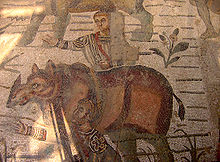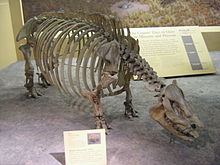Rhinoceros
| Rhinoceros Temporal range: Eocene - Recent
| |
|---|---|

| |
| Black Rhinoceros, Diceros Bicornis | |
| Scientific classification | |
| Kingdom: | |
| Phylum: | |
| Class: | |
| Order: | |
| Family: | Rhinocerotidae Gray, 1821
|
| Extant Genera | |
|
Ceratotherium | |
The Rhinoceros (IPA: [ɹɑɪˈnɒsəɹəs], or Rhino) is any of five surviving species of odd-toed ungulates in the family Rhinocerotidae. Two species are native to Africa and three to southern Asia. Four of the five species are either endangered or critically endangered.
The word "rhinoceros" is derived from the Greek words rhino, meaning nose, and keras, meaning horn; hence "horn-nosed". The plural can be rhinoceros, rhinoceri, or rhinoceroses.
The family is characterised by large size (one of the few remaining megafauna surviving today) with all of the species capable of reaching one ton or more in weight; herbivorous diet; and a thick protective skin, 1.5-5 cm thick, formed from layers of collagen positioned in a lattice structure; relatively small brains for mammals this size (400-600g); and its horn. The rhino is prized for its horn. Not a true horn, it is made of thickly matted hair that grows from the skull without skeletal support. Rhinoceros also have acute hearing and sense of smell, but poor eyesight over any distance. Most rhinoceros live to be about 50 years old or more.
Both African varieties have two horns in tandem while the Asian types have a single horn.
Classification


Several rhinoceros species became extinct within geologically recent times, notably the Giant Unicorn and the Woolly Rhinoceros in Eurasia; the extent to which climate change or human predation was responsible is debated. Current evidence indicates that they probably had survived many climate changes before modern man arrived.
Rhinoceros-like animals first appeared in the Eocene as rather slender animals, and by the late Miocene there were many species. Most were large. One, Indricotherium, may have weighed about 20 tons and (so far as is known) was the largest terrestrial mammal that ever lived. Rhinos in North America became locally extinct during the Pliocene, and in northern Asia, and Europe during the Pleistocene.
The five living species fall into three categories. The critically endangered Sumatran Rhinoceros is the only surviving representative of the most primitive group, the Dicerorhinini, which emerged in the Miocene (about 20 million years ago).[1] The extinct Woolly Rhinoceros of northern Europe and Asia was also a member of this tribe. There are two living Rhinocerotini species, the endangered Indian Rhinoceros and the critically endangered Javan Rhinoceros, which diverged from one another about 10 million years ago. The two African species, the White Rhinoceros and the Black Rhinoceros, diverged during the early Pliocene (about 5 million years ago) but the Dicerotini group to which they belong originated in the middle Miocene, about 14 million years ago. The main difference between black and white rhinos is the shape of their mouths. White rhinos have broad flat lips for grazing and black rhinos have long pointed lips for eating foliage. The name White Rhinoceros was actually a mistake, or rather a corruption of the word wijd (wide in Afrikaans) because of their square lips. White Rhinoceros are divided into Northern and Southern subspecies.
A subspecific hybrid white rhino (Ceratotherium s. simum × C. s. cottoni) was bred at the Dvurkralv Zoo (Zoological Garden Dvur Kralove nad Labem) in the Czech Republic in 1977.
Interspecific hybridisation of Black and White Rhinoceros has also been confirmed [citation needed].



- Family Rhinocerotidae
- Subfamily Rhinocerotinae
- Tribe Aceratheriini
- Aceratherium (extinct)
- Acerorhinus (extinct)
- Alicornops (extinct)
- Aphelops (extinct)
- Chilotheridium (extinct)
- Chilotherium (extinct)
- Dromoceratherium (extinct)
- Floridaceras (extinct)
- Hoploaceratherium (extinct)
- Mesaceratherium (extinct)
- Peraceras (extinct)
- Plesiaceratherium (extinct)
- Proaceratherium (extinct)
- Sinorhinus (extinct)
- Subchilotherium (extinct)
- Tribe Teleoceratini
- Aprotodon (extinct)
- Brachydiceratherium (extinct)
- Brachypodella (extinct)
- Brachypotherium (extinct)
- Diaceratherium (extinct)
- Prosantorhinus (extinct)
- Shennongtherium (extinct)
- Teleoceras (extinct)
- Tribe Rhinocerotini
- Gaindatherium (extinct)
- Rhinoceros - Indian & Javan Rhinoceros
- Tribe Dicerorhinini
- Coelodonta - Woolly Rhinoceros (extinct)
- Dicerorhinus - Sumatran Rhinoceros
- Dihoplus (extinct)
- Lartetotherium (extinct)
- Stephanorhinus (extinct)
- Tribe Ceratotheriini
- Ceratotherium - White Rhinoceros
- Tribe Dicerotini
- Diceros - Black Rhinoceros
- Paradiceros (extinct)
- Tribe Aceratheriini
- Subfamily Elasmotheriinae
- Gulfoceras (extinct)
- Tribe Diceratheriini
- Diceratherium (extinct)
- Subhyracodon (extinct)
- Tribe Elasmotheriini
- Bugtirhinus (extinct)
- Caementodon (extinct)
- Elasmotherium - Giant Unicorn (extinct)
- Hispanotherium (extinct)
- Huaqingtherium (extinct)
- Iranotherium (extinct)
- Kenyatherium (extinct)
- Menoceras (extinct)
- Ougandatherium (extinct)
- Parelasmotherium (extinct)
- Procoelodonta (extinct)
- Sinotherium (extinct)
- Subfamily Rhinocerotinae
Rhinoceros horns

The most obvious distinguishing characteristic of the rhinos is a large horn above the nose. Rhinoceros horns, unlike those of other horned mammals, consist of keratin only and lacks a bony core, such as bovine horns. Rhinoceros horns are used in traditional Asian medicine, and for dagger handles in Yemen and Oman.
One repeated fallacy is that rhinoceros horn in powdered form is used as an aphrodisiac in Traditional Chinese Medicine. It is, in fact, prescribed for life-threatening fevers and convulsions and has been clinically shown to have fever-reducing properties. [2] This misunderstanding has interfered with discussions with TCM practitioners in order to reduce its use since the TCM doctors see it as a life-saving medicine of last resort after cheaper substitutes like water buffalo horn are exhausted. An extensive review of rhinoceros horn in TCM materia medicas shows no aphrodisiac use and the source of the fallacy is not clear unless it was a supposition based on the form that was picked up at a time when sources were more difficult to find in English. [3] China has signed the CITES treaty however. To prevent poaching, in certain areas rhinos have been tranquillized and their horns removed.
Legend

There are a number of legends about rhinoceroses stamping out fire. The story seems to have been common in Malaysia, India, and Burma. This type of rhinoceros even had a special name in Malay, badak api, where badak means rhinoceros and api means fire. The animal would come when a fire is lit in the forest and stamp it out. Whether or not there is any truth to this has not yet been proven, as there has been no documented sighting of this phenomenon in recent history. This lack of evidence may stem from the fact that rhinoceros sightings overall in south-east Asia have become very rare, largely due to widespread poaching of the critically endangered animal. This legend is featured prominently in the film The Gods Must Be Crazy as well as on an episode of The Simpsons.

In James and the Giant Peach by Roald Dahl, James' parents are eaten up by a rhinoceros which escaped from London Zoo even though rhinoceros are, in fact, herbivores. Albrecht Dürer created a famous woodcut of a rhinoceros in 1515, without ever seeing the animal depicted. As a result, Dürer's Rhinoceros is rather inaccurate.
Ancient Chinese practices cite rhinoceros horns as a medicinal remedy for intractable fevers, though there is no modern medical evidence supporting this, causally or correlatively.
References
- ^ Rabinowitz, Alan (June 1995) "Helping a Species Go Extinct: The<33 six. Sumatran Rhino in Borneo" Conservation Biology 9(3): pp. 482-488
- ^ Chinese Herbal Medicine: Materia Medica, Third Edition by Dan Bensky, Steven Clavey, Erich Stoger, and Andrew Gamble. September 2004
- ^ http://seahorse.fisheries.ubc.ca/pdfs/parryjones_and_vincent1998_newscientist.html]Can we tame wild medicine? To save a rare species, Western conservationists may have to make their peace with traditional Chinese medicine. Rob Parry-Jones and Amanda Vincent, New Scientist, volume 157, issue 2115 - 3 January 1998, page 26
- Chapman, January 1999. The Art of Rhinoceros Horn Carving in China. Christies Books, London. ISBN 0-903432-57-9.
- Laufer, Berthold. 1914. "History of the Rhinoceros." In: Chinese Clay Figures, Part I: Prolegomena on the History of Defence Armour. Field Museum of Natural History, Chicago, pp. 73-173.
- Rhinoceros skin and horn characteristics (pdf file)
- Chinese Herbal Medicine: Materia Medica, Third Edition by Dan Bensky, Steven Clavey, Erich Stoger, and Andrew Gamble. September 2004
- [1]]Can we tame wild medicine? To save a rare species, Western conservationists may have to make their peace with traditional Chinese medicine. Rob Parry-Jones and Amanda Vincent, New Scientist, volume 157, issue 2115 - 3rd January, 1998.
- Robinson, Terry J. (2005). "Interspecific hybridization in rhinoceroses: Confirmation of a Black × White rhinoceros hybrid by karyotype, fluorescence in situ hybridization (FISH) and microsatellite analysis". Conservation Genetics. 6 (1): 141–145. doi:10.1007/s10592-004-7750-9.
{{cite journal}}: Unknown parameter|coauthors=ignored (|author=suggested) (help); Unknown parameter|month=ignored (help)
